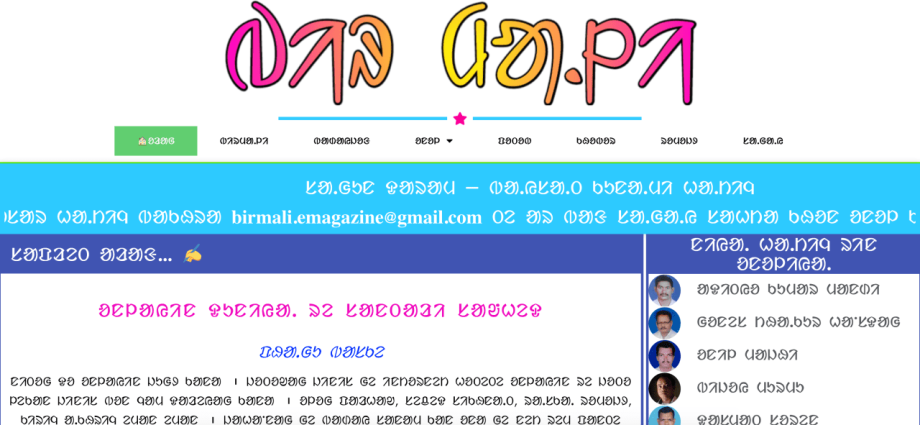This is the first online magazine for 7.6 million Santali speakers
Homepage of the Birmali online magazine. Screenshot from the Birmali website. (Fair use)
Santali language activists from the eastern Indian state of Odisha, have recently published the very first online magazine in the Santali language. Although the 7.6 million native speakers have already seen other kinds of online publications, Birmali magazine is the first of its kind.
Birmali was published to celebrate the 116th birth anniversary of Pandit Raghunath Murmu, also known as “Guru Gomke”, the inventor of Santali writing system Ol chiki. Previous to the invention of OI chiki in 1925, Santali was an oral language which was transliterated in Latin, Devanagari, Odia and Bengali alphabets. Santali was added to the Eighth Schedule of the Indian constitution paving a way for the language to be used as an official language in 2011 in Jharkhand and West Bengal. However, as a language, Santali still faces many challenges. As Shikha Mandi, India’s first Santali radio presenter, explains:
[..]The problem is lies in this — everyone tells me that they don’t understand when I speak in my mother tongue. If everyone starts making Bangla or Hindi or English their own, even Santhalis themselves will forget their own language.[..]
Santals are one of the 700+ indigenous communities that live mostly in India. The Santali diaspora is also spread in Bangladesh, Nepal and Bhutan. The total number of 104 million indigenous people constitute 8.6% of India’s total population as of the 2011 census.
@Naveen_Odisha First ever #santali e-magazine #birmali launched at https://t.co/LKCQo310uy by @BaskeyFagu1 @Ramjit_Tudu @ashwanimurmu on 116th Birth anniversary of Pt. Raghunath Murmu pic.twitter.com/V5DLiTuefp
— ᱵᱤᱨᱢᱟᱹᱞᱤ ᱤ-ᱯᱟᱛᱷᱟᱢ (BIRMALI e-Magazine) (@birmaliemagazin) May 8, 2020
Subhashish Panigrahi from Rising Voices (RV) reached out through Facebook Messenger to three editors from Birmali magazine — Ashwani Banjan Murmu, Fagu Baskey and Ramjit Tudu — to learn about what they envision for the magazine.
Rising Voices (RV): Tell us more about Birmali. What made you start this online magazine?
Fagu Baskey: Birmali is the first-ever online magazine in Santali. The Santali people have very little access to the Santali literature when they can now access the world’s knowledge online. So we started working on bridging this gap. Just like a printed magazine, Birmali includes essays, poetry, stories, book reviews, entertainment news and even a special section for children’s literature.
RV: What is the current landscape of Santali language and Santali publications? How about online publications?
Ramjit Tudu: With official language status and a diaspora spread in India, Bangladesh and Nepal, there are many literary magazines, textbooks that are published in Santali from India. But there are only a few newspapers in print. Santali is poorly represented online. When it comes to web resources, one can find some linguistic resources that have been created by the Centre for Development of Advanced Computing (C-DAC) and some content created by Vikaspedia— both maintained by the Indian government. Besides these two, there is a Santali Wikipedia which would probably be the only encyclopaedic resource in Santali online. We also have a Santali edition of publications like Global Voices and StoryWeaver (children’s literature). Some of us are involved in an initiative called Olchiki Tech which focuses on promoting Santali on digital and online platforms. There are two online news portals — Sar Sagun Patrika and Santali News — that are currently available.
SP: How do you plan to take Birmali to more readers?
Ashwani Murmu: As an online publication gives us the freedom to not have any geographical boundaries, we aim to take Birmali to the Santals who are in India, and also in Bangladesh and Nepal, and even further. We are in contact with the Santali readers and writers outside India. New and emerging as well as well-reckoned writers need a platform to express [themselves]. Similarly, readers also need all forms of literature. We hope to provide that platform to Santali readers and authors for free of any charges, and by using social media to reach out to more readers. Our goal is to have our language at par with the majority languages.
The literacy rates among Santals vary between countries: 48.30% in Nepal to about 55% (55.57% in the state of Odisha and 54.72% in West Bengal — both based on the 2011 census). Lower economic status is one of the major barriers to access education.
Birmali has a long way to go in terms of gaining popularity among Santali readers online. With about 300K monthly unique page views, Santali Wikipedia shows a lower readership on mobile devices — which means that many mobile users are yet to read or type in Santali on mobile platforms. A larger user base of Santali language in South Asia consists predominantly of mobile internet users.
Note: During 2014-2015, the author was involved in his official capacity as a programme officer at the Centre for Internet and Society’s project to create an input tool and a font in Santali.











